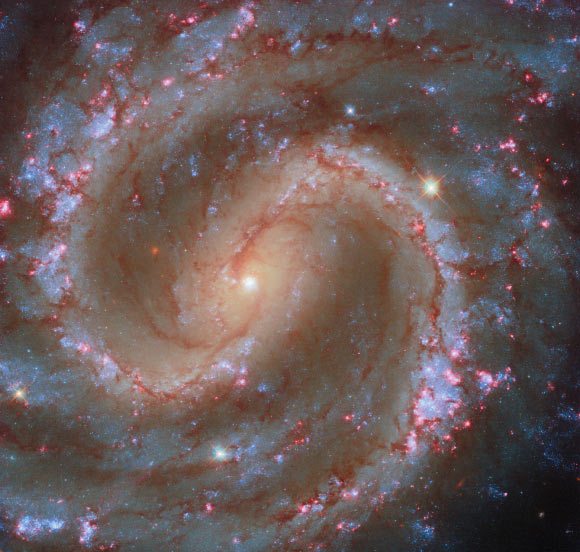Astronomers using the NASA/ESA Hubble Space Telescope have obtained a remarkable new image of the barred spiral galaxy NGC 4535.

This Hubble image NGC 4535, a spiral galaxy located some 52.6 million light-years away in the constellation of Virgo. Image credit: NASA / ESA / Hubble / F. Belfiore / J. Lee / PHANGS-HST Team.
NGC 4535 is located around 52.6 million light-years away in the constellation of Virgo.
Otherwise known as LEDA 41812 and UGC 7727, this galaxy is 115,000 light-years across.
It was first observed by the German-British astronomer William Herschel on December 28, 1785.
When seen through a smaller telescope, NGC 4535 has a hazy, ghostly appearance, which inspired the prominent amateur astronomer Leland S. Copeland to name it ‘The Lost Galaxy’ in the 1950s.
“This galaxy has been nicknamed the ‘Lost Galaxy’ because it’s extremely faint when viewed through a small telescope,” the Hubble astronomers said in a statement.
“With a mirror spanning 2.4 m across, Hubble is well equipped to observe dim galaxies like NGC 4535 and pick out features like its massive spiral arms and central bar of stars.”
NGC 4535 is one of the largest galaxies in the Virgo Cluster, a massive cluster of as many as 2,000 galaxies, and is located close to the giant elliptical galaxy Messier 87.
The galaxy’s almost circular appearance shows that we observe it nearly face-on.
In its center, there is a well-defined bar structure, with dust lanes that curve sharply before the spiral arms break from the ends of the bar.
“On full display in the Hubble image are NGC 4535’s young star clusters, which dot the galaxy’s spiral arms,” the astronomers said.
“Many of the groupings of bright blue stars are enclosed by glowing pink clouds.”
“These clouds, called H II regions, are a sign that the galaxy is home to especially young, hot, and massive stars that are blazing with high-energy radiation.”
“By heating the clouds in which they were born, shooting out powerful stellar winds, and eventually exploding as supernovae, massive stars certainly shake up their surroundings.”
The new Hubble image incorporates data from an observing program that will catalogue roughly 50,000 H II regions in nearby star-forming galaxies.
“A previous image of NGC 4535 was released in 2021,” the researchers said.
“Both the 2021 image and today’s image incorporate observations from the PHANGS program, which seeks to understand the connections between young stars and cold gas.”
“Today’s image adds a new dimension to our understanding of NGC 4535 by capturing the brilliant red glow of the nebulae that encircle massive stars in their first few million years of life.”


![The image shows NGC 1866 superimposed with a false color image from the MUSE data cube, where the ionized shell of the planetary nebula Ka LMC 1 is seen as a red ring. The grayscale insets illustrate the different size of the ionized shells of singly ionized nitrogen [N II] and doubly ionized oxygen [O III]. The magnified Hubble image near the center of the ring reveals the presence of a pale blue star -- most probably the hot central star of Ka LMC 1. Image credit: AIP / M.M. Roth / NASA / ESA / Hubble.](https://cdn.sci.news/images/2025/11/image_14348-Ka-LMC-1-104x75.jpg)




